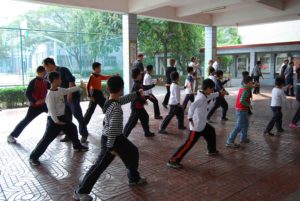Reduce Fear of Pain at Work and Musculoskeletal Pain with Mindfulness
By John M. de Castro, Ph.D.
“a regular meditation practice is the best ongoing foundation for working with pain. Mindfulness practice is a wonderful opportunity to do just that. It helps to shift the locus of control from the outside (“this is happening to me and there is nothing I can do about it”) to the inside (“this is happening to me but I can choose how I relate to it”). – Mindful
We all have to deal with pain. It’s inevitable, but hopefully it’s mild and short lived. For a wide swath of humanity, however, pain is a constant in their lives. At least 100 million adult Americans have common chronic pain conditions. It has to be kept in mind that pain is an important signal that there is something wrong or that damage is occurring. This signals that some form of action is needed to mitigate the damage. This is an important signal that is ignored at the individual’s peril. So, in dealing with pain, it’s important that pain signals not be blocked or prevented. They need to be perceived. But, methods are needed to mitigate the psychological distress produced by chronic pain.
The most common treatment for chronic pain is drugs. These include over-the-counter analgesics and opioids. But opioids are dangerous and prescription opioid overdoses kill more than 14,000 people annually. So, there is a great need to find safe and effective ways to lower the psychological distress and improve the patient’s ability to cope with the pain. Pain involves both physical and psychological issues. The stress, fear, and anxiety produced by pain tends to elicit responses that actually amplify the pain. So, reducing the emotional reactions to pain may be helpful in pain management. Mindfulness practices have been shown to improve emotion regulation producing more adaptive and less maladaptive responses to emotions. Indeed, mindfulness practices are effective in treating pain.
In today’s Research News article “Ten weeks of physical-cognitive-mindfulness training reduces fear-avoidance beliefs about work-related activity: Randomized controlled trial.” See summary below or view the full text of the study at:
https://www.ncbi.nlm.nih.gov/pmc/articles/PMC5400305/, Jay and colleagues examine a fear avoidance model of pain where a vicious circle develops creating more pain. The individual when they start to move and feel pain, interpret the pain as potentially damaging and so alter their movements. This is counterproductive and can create more pain, producing more pain avoidance behaviors, producing even more pain, etc. To examine this idea, they recruited female laboratory assistants who were suffering from chronic musculoskeletal pain and randomly assigned them to receive either physical-cognitive-mindfulness training or to follow treatment-as-usual. Therapy consisted of 10 weeks of exercise, cognitive behavioral therapy, and mindfulness training. They were measured before and after training for pain intensity, pain frequency, and leisure time and work related pain fear avoidance.
They found that before training, as predicted, there were significant positive relationships between work pain fear avoidance and pain, particularly in the neck and shoulders, such that the greater the pain fear avoidance the greater the pain. They also found that in comparison to the treatment-as-usual control group that the physical-cognitive-mindfulness training group had significant improvements after training of over 50% in pain and in work related pain fear avoidance. Leisure time pain fear avoidance was not related to pain and not affected by the treatment.
The results suggest that work related pain fear avoidance is related to musculoskeletal pain intensity and that physical-cognitive-mindfulness training improves both. These relationships, however, are situation specific as leisure time pain fear avoidance was unrelated. It is unclear if the relationships between pain and pain fear avoidance are causal because of the correlative nature of the relationships. It is also unclear which, or which combinations, of the three components of the treatment was effective in reducing pain and pain fear avoidance. The results, however, are interesting and should be followed up with further research.
So, reduce fear of pain at work and musculoskeletal pain with mindfulness.
“Chronic pain is frustrating and debilitating. The last thing we want to do is pay more attention to our pain. But that’s the premise behind mindfulness, a highly effective practice for chronic pain (among other concerns).” – Margarita Tartakovsky
CMCS – Center for Mindfulness and Contemplative Studies
This and other Contemplative Studies posts are also available on Google+ https://plus.google.com/106784388191201299496/posts and on Twitter @MindfulResearch
Study Summary
Jay, K., Brandt, M., Jakobsen, M. D., Sundstrup, E., Berthelsen, K. G., schraefel, mc, … Andersen, L. L. (2016). Ten weeks of physical-cognitive-mindfulness training reduces fear-avoidance beliefs about work-related activity: Randomized controlled trial. Medicine, 95(34), e3945. http://doi.org/10.1097/MD.0000000000003945
Abstract
People with chronic musculoskeletal pain often experience pain-related fear of movement and avoidance behavior. The Fear-Avoidance model proposes a possible mechanism at least partly explaining the development and maintenance of chronic pain. People who interpret pain during movement as being potentially harmful to the organism may initiate a vicious behavioral cycle by generating pain-related fear of movement accompanied by avoidance behavior and hyper-vigilance.
This study investigates whether an individually adapted multifactorial approach comprised of biopsychosocial elements, with a focus on physical exercise, mindfulness, and education on pain and behavior, can decrease work-related fear-avoidance beliefs.
As part of a large scale 10-week worksite randomized controlled intervention trial focusing on company initiatives to combat work-related musculoskeletal pain and stress, we evaluated fear-avoidance behavior in 112 female laboratory technicians with chronic neck, shoulder, upper back, lower back, elbow, and hand/wrist pain using the Fear-Avoidance Beliefs Questionnaire at baseline, before group allocation, and again at the post intervention follow-up 10 weeks later.
A significant group by time interaction was observed (P < 0.05) for work-related fear-avoidance beliefs. The between-group difference at follow-up was –2.2 (–4.0 to –0.5), corresponding to a small to medium effect size (Cohen’s d = 0.30).
Our study shows that work-related, but not leisure time activity-related, fear-avoidance beliefs, as assessed by the Fear-avoidance Beliefs Questionnaire, can be significantly reduced by 10 weeks of physical-cognitive-mindfulness training in female laboratory technicians with chronic pain.









